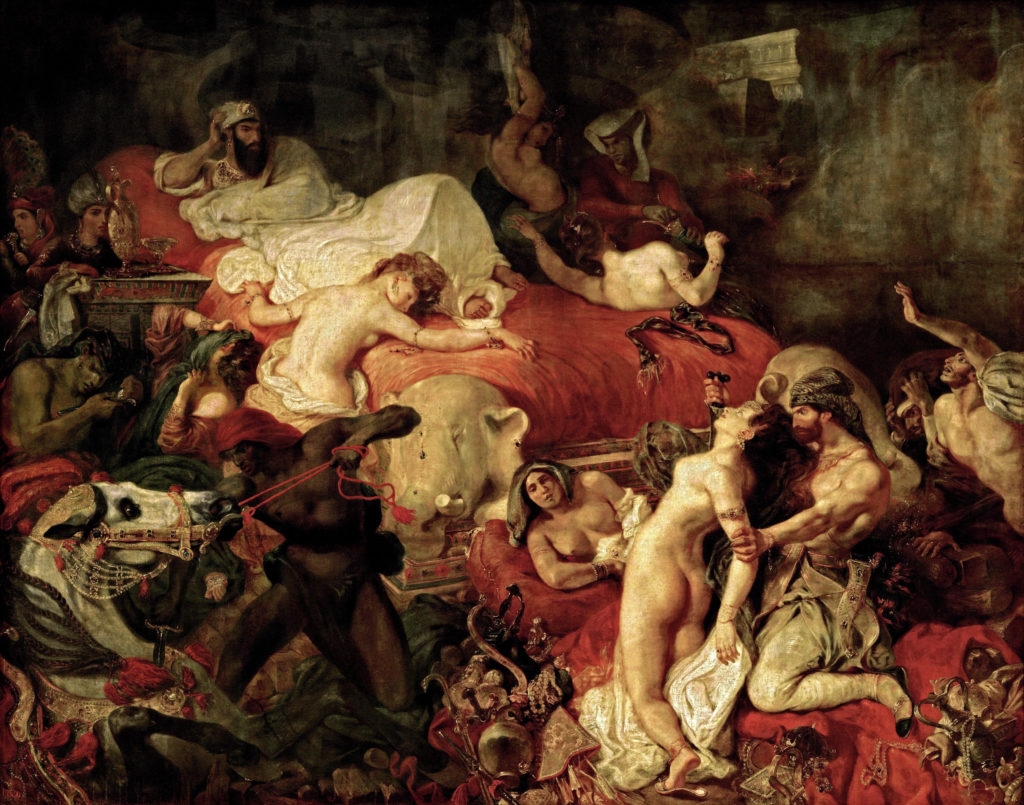Bette Midler observed that it might be twenty to one in the morning in New York, but it’s still 1940 in London. In which case, it’s still a quarter past six in the evening in Paris. If history marches like a timepiece, then France’s clock stopped in 1815, around eight on the night of June 18 when, as the charge of Napoleon’s chasseurs crested the ridge that lay between his lines and Wellington’s center, the riflemen of the 1st Foot Guards rose up from the reverse slope and opened fire at point-blank range. The wild ride that began at the Bastille in 1789 ended outside Brussels in a wet meadow—in Brabant Dutch, a waterloo.
Historians may insist that Napoleon’s defeat was sealed at 1630 hours, when the Prussians attacked Napoleon’s flank at Plancenoit. But memory is emotional, and national memory is mythical. A dance of death and glory: mounts and men, rearing and flailing, tumbling together into the mud in fatal synchrony as blood flecks the cavalryman’s fur-trimmed pelisse and the straining flanks of his horse; the Foot Guards rushing against the loose French squares, red and blue coats wrestling as the bayonet hovers over the chest and the body recoils from the musket ball; the counter-charge of chasseurs who rear over the British artillerymen at the hilltop, the brass hilts of their sabers flecked with the gold of sunset, the blades silver and carmine; the flank attack and foot charge from the British skirmishers, the chaos of the mêlée; and then, as the surviving riders, wrenching the reins hard down, twist their horses’ necks and flee—Wellington, deploying his trademark footwear, standing in his stirrups, and waving his black bicorn hat for the general advance.
It should be a canvas by Eugène Delacroix, but it cannot be one. In the 1870s, Alfred Cadart published an etching after Delacroix by Adolphe Martial-Potémont called Waterloo. In Delacroix’s drawing, a lone traveler lies on a bare reverse slope, his body merging into those of his two dead horses. His Waterloo, like the one that abba sang about in the 1970s, is strictly metaphorical. The title was tacked on by Cadart, perhaps in a moment of inspired cynicism, perhaps in acknowledgement that no one painted other people’s Waterloos quite like Delacroix.
All modern painting is after Delacroix, and Delacroix painted after Waterloo. Delacroix’s brush loosened the Grand Manner so that historical narrative and its motto of virtue become amoral, sensual, self-conscious, egotistical, nostalgic for order and authority, and voyeuristically aroused by the spectacle of their undoing—modern, as the French called it. The same symptoms had characterized the Revolution’s blood-greased slide from virtue to depravity, and the rise of Napoleon as modern Caesar. The affliction and its aftershocks defined Delacroix’s era. He knew it, too, for self-consciousness was part of the Romantic curse. In 1827, when The Death of Sardanapalus found no buyers, Delacroix realized too late that “the infernal felicity of the brush,” had caused “my Waterloo.”
All modern painting is after Delacroix, and Delacroix painted after Waterloo.
Born in 1798, the year that Napoleon invaded Egypt, Delacroix was seventeen when the catastrophe at Waterloo obliged him to seek gloire by the brush, not the sword. He inherited the Romantic agony: the substitution of art for action, aesthetics for sword and spurs—the last stand of antagonism against irrelevance as the image of one “lame devil,” Talleyrand the politician, becomes that of another, Lord Byron the celebrity.
“Tomorrow I shall attack that cursed tablecloth which will be my Austerlitz or my Waterloo,” Delacroix told Frédéric Villot in 1829, as he prepared for the crisis of another Belgian bloodbath, The Assassination of the Bishop of Liège. The discovery of the Will, that philosophical property Schopenhauer posited in 1818, three years after Waterloo, suggested that the historical canvas might be a blank canvas. The democratic revolutions had revealed the hereditary dynasty as a costume drama, its final act the fall of the guillotine, the raising of the head, the acclaim of the audience. The dictatorship that ensued repurposed the materials of permanence as the props of a repertory of power, with Napoleon directing himself in the role of the new Charlemagne.
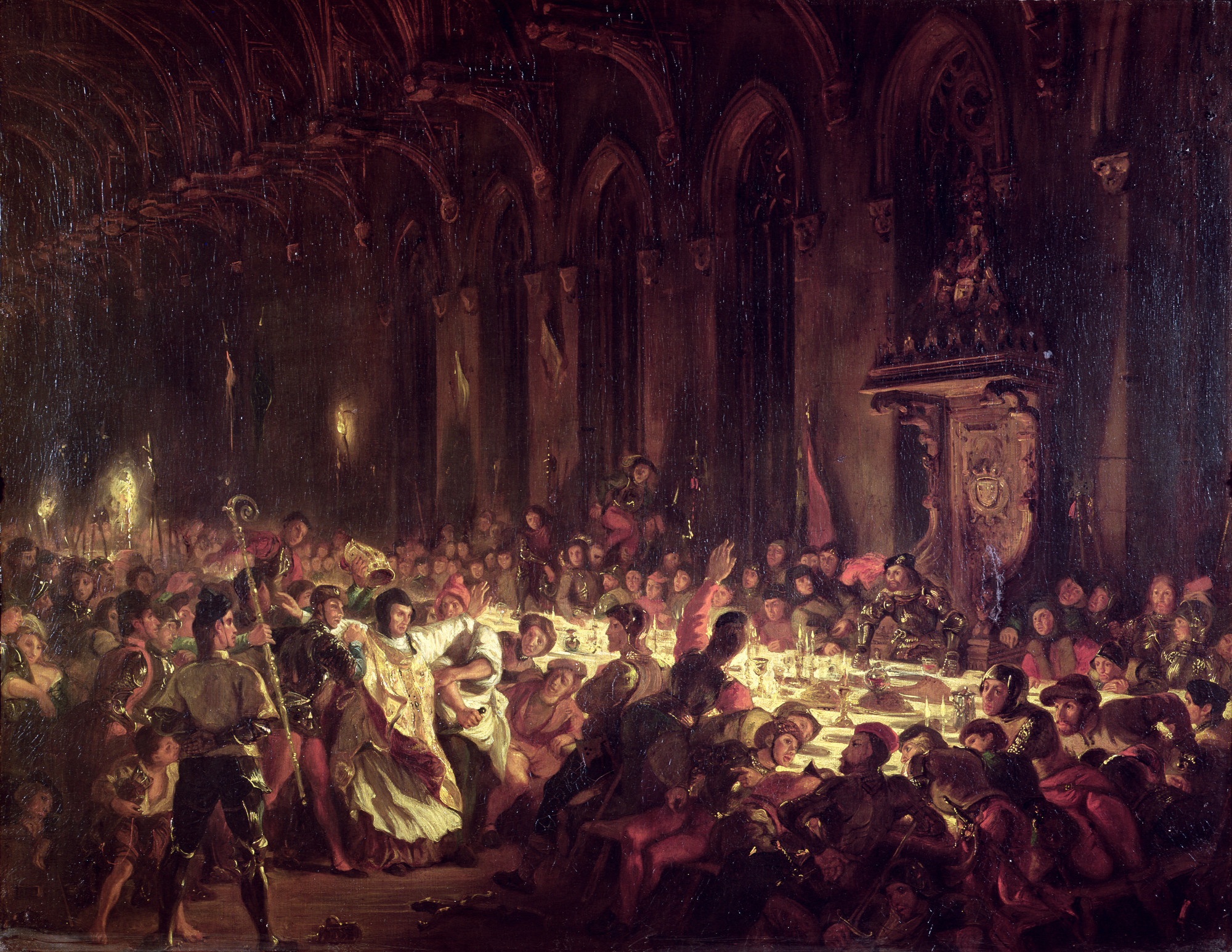
Delacroix painted under seven different regimes, none of them stable: the Directoire of 1795, in which his nominal father Charles-François Delacroix was succeeded as foreign minister by his alleged father, Prince Talleyrand; the First Empire of 1804; the Bourbon restoration of 1814; the headless interlude of the Hundred Days, when Napoleon returned and Louis XVIII fled Paris; the July Monarchy of 1830, whose revolutionary moment Delacroix defined as Liberty Leading the People; the Second Republic of 1848, which Delacroix did not define, because he was more interested in painting still lifes of flowers and the stilled life of Jesus; and the Second Empire of 1852, from which Delacroix again demurred, though perhaps wisely—a colorist in the line of Titian and Rubens was never going to be comfortable in an era that Karl Marx defined as a historical grisaille, “gray on gray.”
“Delacroix” is the first comprehensive Delacroix retrospective since 1963.1 The president then was Charles de Gaulle, who had lately founded a fifth attempt at a French republic, and extracted France from the Algerian terroir that Delacroix had found so scenic and cruel. In 1837, commissioned by the new monarchy of Louis-Philippe to supply something patriotic, Delacroix had painted an anti-Waterloo, The Battle of Taillebourg, in which Louis IX, succeeding where Bonaparte’s cavalry had failed, smashes through the English lines on a white charger. In 1940, de Gaulle had laid his own palimpsest over the memory of Waterloo, by broadcasting his “Appeal of June 18” from London on the anniversary of what had, until then, been France’s most humiliating defeat. The broadcast has been called the formal beginning of the French Resistance. The number of listeners remains in dispute, but quibbles over detail shall not diminish the appeal of the Appeal.
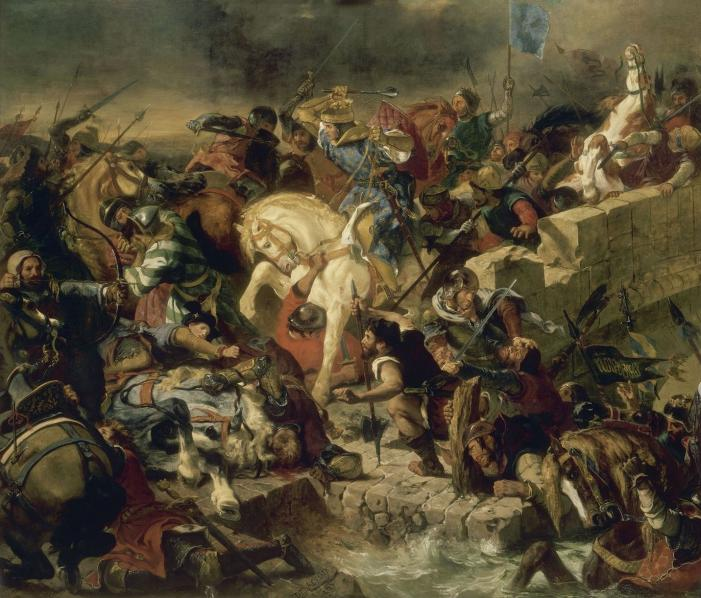
This exhibition, which I saw in its original run at the Louvre, occurs in the reign of Emmanuel Macron, a half-pint Napoleon in his ambition to complete the building of a new European empire, a digital de Gaulle in his aspiration to contrive gloire from France’s modern mess. The exhibition partakes in the Macron rebranding by arguing that Delacroix is better understood through his “quest for singularity” and “belief in the expressive power of painting,” and not through Romanticism. This assertion is, however, Romantic in its hope that history is plastic, Romantic in its dream that an individual gesture can shape it, and Romantic in its delusion that the time is now.
History is plastic; paint is plastic.
The modern declivity from history to fiction, fact to wish, turned the sacred materials of history painting into the drama of the moment. Delacroix took The Assassination of the Bishop of Liège from Sir Walter Scott’s Quentin Durward (1823). “In assigning the present date to the murder of the Bishop of Liège, Louis de Bourbon, history has been violated,” Scott admitted in his preface. Scott’s novel is set in 1468, the year that the Liégeois and their bishop, Louis de Bourbon, were incited by Louis XI to rebel against Charles the Bold of Burgundy. The bishop was assassinated in 1482, on the orders of William de la Marck, a German adventurer who planned to put his own son into the bishopric. William de la Marck was probably up to no good in 1468, but he had yet to become notorious as the “Wild Boar of the Ardennes.” Still, considerations of plot obliged Scott to place de la Marck at the scene in 1468, and to have the bishop whacked with a meat cleaver in a crowded banqueting hall.
History is plastic; paint is plastic. Delacroix takes further liberties with Scott’s material. Like the white shirt of the aristocrat at the guillotine, the bishop’s white robe is a proleptic shroud, a prepared canvas for the spurt of blood. A retainer raises a hand, to notify de la Marck, but the Wild Boar is already on his feet. Enraged, he compresses his fists onto the white tablecloth as if preparing to spring over the table like a monkey and attack the bishop with his bare hands. Two more retainers watch the bishop, forming two points of a tight triangle with him. One leans on a chair in front of the bishop, arms crossed as he assesses his neck. The other stands to the bishop’s right, his hands folded behind his back.
When the retainer with the raised arm drops his hand, its arc will fall through the man who leans on the chair and down the center of the bishop’s body. When the Boar points a finger, the killer will reach for the blade. When the blade comes out, the folded arms will unfold. When the blade goes in, the bishop’s arms, now spread wide, will collapse inwards. Everyone’s arms contain the threat of action. But who is the killer?
If we have read Quentin Durward, we know that the killer is Nikkel Blok, the local butcher. On de la Marck’s order, Blok will rise from the table and stand behind de la Marck’s chair, his cleaver “uplifted in his bare and sinewy hands.” Again as ordered, Blok will strike “as if he was doing his office in the common shambles.” De la Marck will then address the shocked witnesses with the immortal words, “How now, ye porkers of Liège!” But Blok is not where Scott left him. The chair in Delacroix’s painting is an episcopal throne, massive, carved, and big enough to hide a sinewy butcher and a couple of sheep too. The killer is on the loose, somewhere in the canvas. Delacroix has set up the plot lines of a denouement: the pointed finger, the falling arm, the two points of the triangle converging on the bishop. But these are red herrings.
Blok is already at the bishop’s left elbow, and his arms are already in motion. He wears the red hat and dirty apron of his office. He has already rolled up his left sleeve, and is now rolling his right. And his left holds a long knife. Delacroix has encouraged us to misread the scene, so that the suspicion of one horror leads to the thought of a greater horror. It is later than we and the bishop think. The order has already been given. The other two retainers are leaning back, to enjoy the show, and de la Marck is coiled in anticipation. The bishop, still looking at the man who leans on the chair and the man with the raised arm, is about to receive a backhand to the guts, and die more slowly and horribly than an animal in the common shambles. Are his open arms an appeal for mercy, or a surrender to a blade he does not see, but which already has his name on it?
“Delacroix, lac de sang, hanté des mauvais anges,” Baudelaire wrote in “Les Phares” (“The Beacons”): “Delacroix, lake of blood, haunted by evil angels.”
See one Delacroix, and you are stunned by the proficiency of color, the brushstrokes that carry the line and light together, the weaving of limbs and weapons. See a room of Delacroix, and you are overwhelmed by the flamboyance with which he apportions historical weight and narrative, or adjusts the posture of his lions and horses. See his life’s work, and you sense that he is lifting the skin of life from the flesh. As the focus of ambition turns from the Empire to art, the imagery of history painting—the heroes and battles, the drapery and roles—pulls away from its narrative structures. The subject of painting splits into two subjects, one a depersonalized physical world of suffering, the other the surface of paint itself, alive with transcendent potential. We are looking at a visual analogue to the “Spleen et Idéal” of Baudelaire.
The rare scale of “Delacroix” allows both for lateral comparison between finished paintings, and for tracing the development of individual paintings. Delacroix is pursuing two goals at once: the articulation of color and line and the expression of narrative. He picks through his costume trunk, reworks the conventions of his academic training, and moves his figures from one narrative to another. The extended necks of both the drowning man who clings to the boat with his teeth and the expressionless drowned man who slips into the water in The Barque of Dante (1822) recur in the poses of the dead woman with an infant at her breast and the bound woman with her face averted in The Massacre at Chios (1824). The blue-shirted man who climbs for succor towards the passing breast in Liberty Leading the People echoes the blond boy who crawls towards his dead mother’s breast in The Massacre at Chios. The sleeping soldier in The Corps de Garde at Meknes (1847) reclines his head like the title subject of Turkish Officer Killed in the Mountains (The Death of Hassan) (1826).
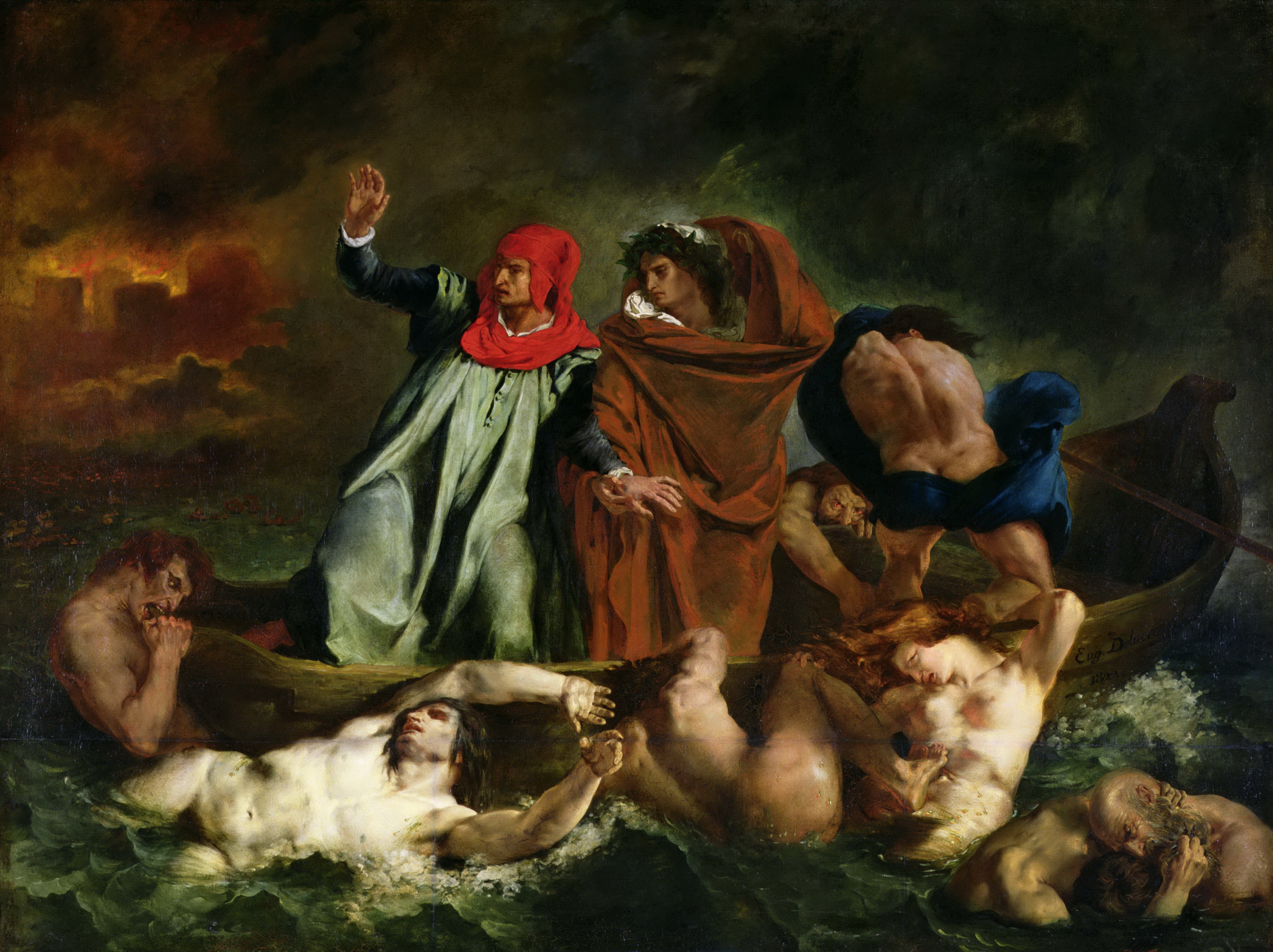
The recurrence and variation of poses is reminiscent less of Rubens than of Tiepolo. But Tiepolo worked in the pre-revolutionary age, the lost idyll that Talleyrand defined as douceur de vivre. His repetitions are the routines of the repertory company, not the compulsions of religion or ritual. Only in his series of etchings, the Vari Capricci and Scherzi di Fantasia, does Tiepolo suggest the modernity that Delacroix will make explicit in what he called “nice, oily, thick paint”—compulsive and violent repetitions that, unable to attain the transcendence of a rite, fail to supply the satisfactions of religion, but nonetheless sate the carnal appetite and the cruel eye. The patterns of behavior in Delacroix are between religion and anthropology. The ritual repeats itself for its own reasons, and the individual rationales of myth or history dissolve into the generic requirements of nature. Everywhere, the neck is exposed and the knife raised. One eye widens in fear as another closes in lust. The two maternal fluids that must be kept separate, milk and blood, are mixed in the revolutionary moment, but the nature of their reconstitution is not shown.
Delacroix is a hussar of the brush, dragooning stories, models, and props into glorious death.
The force is clearer than the motive, and the depth created by intermediate layers of thinned paint lifts the surface away from its subject. In the sketch for Lion Hunt (1855), Delacroix knows that he wants something blue in the bottom-left corner, so he makes it the decorative tuft of the turban of the man who is pinned by the lion. He then sets this blue tuft within rings of red and white, in a kind of presentation. He retains this arrangement in both the small and large finished canvases, but he keeps tinkering with the kneeling figure in the right foreground. This figure is more dynamic than the pinned man; like Nikkel Blok the butcher, he has the chance to thrust his blade into his enemy’s stomach. Delacroix retains this man’s blue cape, but adds gold trim to his pink jacket in the small finished version. In the larger finished version, the man’s jacket is blue, and he gains a gold waistcoat and brown cape. Now the gold of the waistcoat flows towards the horse’s green-and-gold decorative armor. The painted surface now forms its own passage, distinct from the passages of narrative.
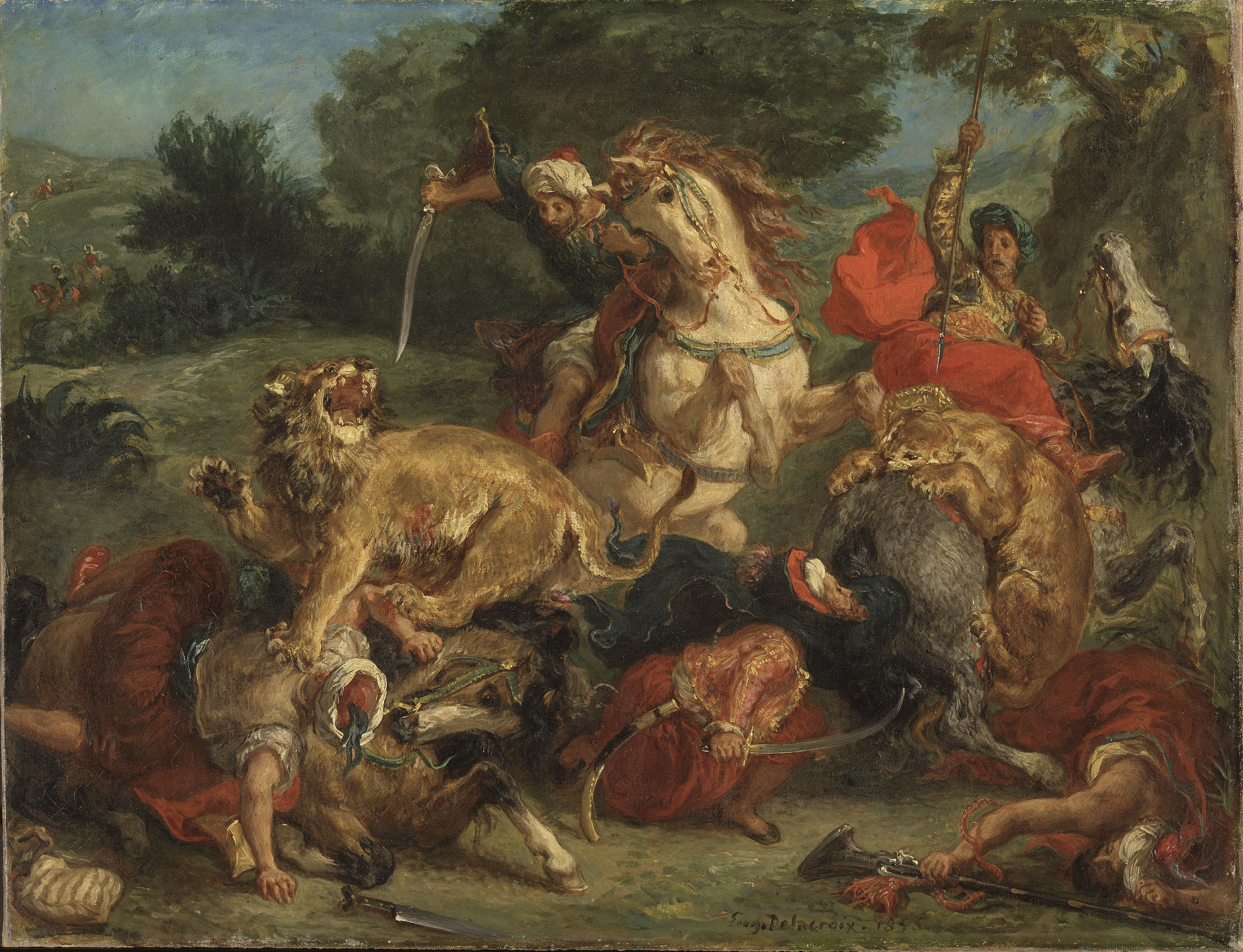
As he adjusts his palette and poses, and tinkers with the lighting and the props, Delacroix sharpens the image of nature without committing to naturalism. The selections in the Met’s supplementary exhibition, “Delacroix Drawings,” demonstrate that Delacroix intensified by the modern method of exclusion, rather than the Enlightenment method, encyclopedic inclusion.2 The poses of Medea and her two children remain stable between the oil sketch of ca. 1836 and the finished Medea (1838). But now Medea’s yellow dress turns pink and drops off her shoulders to show her breasts. The blue cape that blew in the wind at her shoulder is gone. The aubergine tone of the cape on her knees splits into blue and red, the colors of a chasseur’s cape. The scene has moved from an exposed recess in a cliff by the sea to a shadowed cave. Medea’s hair, now loose down her back where previously it was tucked into a diadem, is moving not because of the wind—there is none, because she is sheltered—but from the nervous turn of her neck as she checks whether she will be seen in the act of infanticide.
Seen, that is, by anyone apart from the viewer. Delacroix is a hussar of the brush, dragooning stories, models, and props into glorious death. Substituting art for war, he sacrifices the distinct categories of myth and history, generating the visual equivalent to the modern Greek word for a novel, mythistorema, a “myth-history.”
“La garde meurt, elle ne se rend pas,” the Old Guard cried as they made their last stand at Waterloo. “The Guard dies, it does not surrender.”
1 “Delacroix” opens at the Metropolitan Museum of Art, New York, on September 17, 2018 and remains on view through January 6, 2019. The exhibition was previously on view at the Louvre Museum, Paris, from March 29 through July 23, 2018.
2 “Delacroix Drawings” opened at the Metropolitan Museum of Art, New York, on July 17 and remains on view through November 12, 2018.
